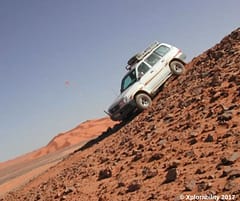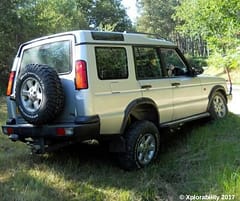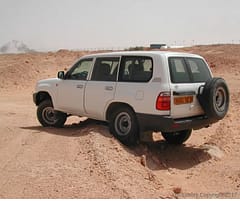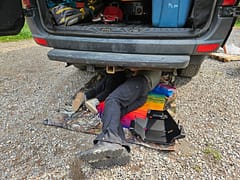Ascending Hills and Slopes While Off-Roading
Climbing Up in Your 4x4
Contents
- Ascending Hills and Slopes
- Failure to Ascend ENGINE STILL RUNNING
- Failure to Ascend ENGINE STILL RUNNING
- Engine Stall during Ascent
Ascending Hills and Slopes
How do you drive up steep slopes successfully and safely? We’ve got you covered, check out how to ascend hills and slopes, we even tell you what to do if you fail at the climb, don’t have hill descent control, have an automatic or a manual.
This content was developed by and owned by Paul Sinkinson, Xplorability owner. Paul is a 4wd Defensive Driver Training Consultant/Trainer and Programme Developer.
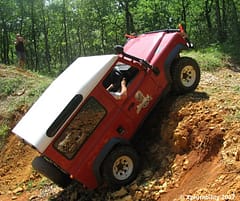
11 Tips for Ascending Hills and Slopes
-
Carry out Hazard ID and Safety Margin checks including run out areas should ascent fail.
-
Engage low ratio 4wd (Plus Centre Diff-Lock) to control reversing speed if you fail to climb. Land Rover Discovery 2 Vehicles engage Hill Descent Control (HDC). You engage HDC to assist your Descent should you fail the Ascent. Further details on how to use 4wd low here.
-
Be clear in your mind of the failure to climb procedures before attempting the Climb.
-
Check over the top of the climb before attempting. (Never drive blind)
-
Select a suitable gear and STAY IN IT. Usually 2nd will reduce wheel-spin – sometimes if a long enough run up on a progressive hill climb it is possible to change up to 3rd BUT be aware as the hill gets steeper although 3rd may reduce wheel-spin it may be too high a gear and the engine will overload and stall or IF you try and change back to 2nd you will lose momentum and fail the climb anyway.) As mentioned, choose a Gear and STAY IN IT. If you fail the Climb use the the Failed ascent procedure come back down safely and rethink the situation.
-
Drive as fast as necessary and as slow as possible, utilize controlled vehicle momentum where necessary. Remember, weight will have transferred to the rear wheels, the front wheels will be light and easily lose traction.
-
Utilize wheel tracks where possible to control directional stability. Never straddle deep wheel ruts when ascending steep hills to avoid potential rollover.
-
Always drive straight up, avoid traversing.
-
Be aware of ground contour. Maximize traction by avoiding a route with extreme humps and hollows. Once the wheels bounce you will lose traction and get wheel-spin. If wheel spin occurs, decelerate then re-apply throttle gently.
-
ALWAYS Check your mirrors as you climb so you are aware if another vehicle or someone on foot is following you on the track to your rear.
-
Lower tyre pressures will increase traction in most situations. Beware of under-inflation causing bead to tyre separation. Remember to re-inflate your tyres before driving at highway speeds.
Drive as slow as possible and as fast as necessary, drive with Mechanical Sympathy at all times
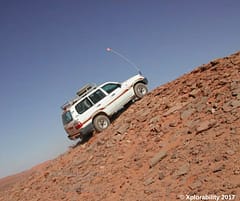
Failure to Ascend ENGINE STILL RUNNING
(Manual Transmission)
For Automatic Transmission Vehicles the operation is different so please check the Automatic Transmission Section.
If forward motion is lost, apply footbrake and clutch simultaneously. In certain situations it may be preferable to use the brake only and allow the engine to stall which may give you more security. If this is the case use the Stalled Ascent technique to descend.
Depressing the CLUTCH stops the engine Stalling – Applying the BRAKE stops you rolling backwards while you access the situation.
Avoid using handbrake if it is a Transmission Brake as this may lock on and cause problems.
Check your Mirrors to verify it is safe to reverse. Test the Wheels are facing straight ahead.
Select reverse Gear, Test that Reverse is fully engaged. Double check the Mirrors. Use the Horn.
NOW – IMPORTANT – Gently release clutch UNTIL you feel it start to BITE against the TRANSMISSION and then RELEASE THE BRAKE FULLY as you do, let the CLUTCH OFF FULLY at the same time to let the engine braking to allow a safe and controlled descent. The Reason you do it this way is so that you are NOT Tempted to put the CLUTCH BACK IN Again which without the BRAKE being on would let the vehicle suddenly run away and accelerate backwards – LEAVE YOUR CLUTCH FOOT FIRMLY ON THE CAB FLOOR.
ALLOW THE HILL DESCENT CONTROL (HDL - if installed) To look after wheel traction and to make for a safe descent. DO NOT TOUCH THE BRAKE if using HDC or it WILL DISENGAGE. NON HDC Vehicles you can cover the brakes and use them gently to avoid wheel lock up - With Non HDC if the wheels lock up, accelerate gently momentarily so the wheels regain the speed of the sliding vehicle and you should then regain traction and directional control.
PRACTICE THIS ON GENTLE SLOPES UNTIL YOU FULLY UNDERSTAND THE METHOD
If forward motion is lost, apply footbrake and clutch simultaneously. In certain situations it may be preferable to use the brake only and allow the engine to stall which may give you more security. If this is the case use the Stalled Ascent technique to descend.
Depressing the CLUTCH stops the engine Stalling – Applying the BRAKE stops you rolling backwards while you access the situation.
Avoid using handbrake if it is a Transmission Brake as this may lock on and cause problems.
Check your Mirrors to verify it is safe to reverse. Test the Wheels are facing straight ahead.
Select reverse Gear, Test that Reverse is fully engaged. Double check the Mirrors. Use the Horn.
NOW – IMPORTANT - Gently release clutch UNTIL you feel it start to BITE against the TRANSMISSION and then RELEASE THE BRAKE FULLY as you do, let the CLUTCH OFF FULLY at the same time to let the engine braking to allow a safe and controlled descent. The Reason you do it this way is so that you are NOT Tempted to put the CLUTCH BACK IN Again which without the BRAKE being on would let the vehicle suddenly run away and accelerate backwards – LEAVE YOUR CLUTCH FOOT FIRMLY ON THE CAB FLOOR.
IF the Vehicle does NOT have HDC - Cover brake pedal and if the vehicle is going too quickly, lightly utilise brakes if traction permits. If the wheel locks, the vehicle may descend rapidly in a slide. If this is the case, gently accelerate to regain traction and directional control. IF Vehicle has HDC DO NOT TOUCH BRAKE OR THROTTLE OR IT WILL DISENGAGE.
Reverse to base of hill. IF NO HDC - If wheels lock up, release brakes to regain steering then re-apply gently. Hold steering wheel firmly to avoid steering kickback.
If engine stalls while in reverse, (manual transmissions only), turn ignition key to restart engine with feet clear of pedals, as engine starts cover brakes and reverse down slope.
At ALL times descend using the Mirrors, as by doing this you still have peripheral forward vision and can recognise if the front of the vehicle is sliding sideways. If you look over your shoulder you may not see this and, there is also a tendency to turn the wheel which may destabilize the directional control. Ensure vehicle remains vertical on hill. IE: Watch excessive over steer.
Before you climb a hill, always ensure you know what is on the other side
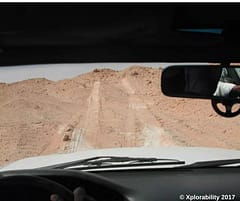
Failure to Ascend ENGINE STILL RUNNING
(Automatic Transmission)
If forward motion is lost, apply foot brake. (It is unusual for the engine to stall). You use the foot brake for security as depending on how steep the incline the Auto Transmission may not hold you stationary. If for whatever the reason the engine does stall, it will be necessary to engage neutral and restart, do not use PARK as the weight of the vehicle on the transmission may make it difficult to disengage the lever. Now, follow the Stalled Ascent or Failed Ascent techniques to descend.
ENSURE THAT THE HILL DESCENT CONTROL SYSTEM IS ENGAGED IF FITTED (A Green Light will appear in the top left side of the Dash Panel to indicate it is engaged)
You have applied the BRAKE to stop you rolling backwards while you access the situation.
Avoid using handbrake if it is a Transmission Brake as this may lock on and cause problems.
Check your Mirrors to verify it is safe to reverse. Test the Wheels are facing straight ahead.
Select reverse Gear, You will see that Reverse is engaged on the Dash Panel R. Double check the Mirrors. Use the Horn. (This is to warn others you are going to move)
NOW – IMPORTANT - The vehicle will at first start to move backwards quickly – Don’t Panic and DON’T TOUCH THE BRAKE PEDAL – Initially engine braking will take over until the HDC recognises it is needed (circa 6mph) it will then take over, slow the vehicle down and control the wheel speeds independently to avoid them locking up and slipping and will allow a safe and controlled descent.
IF the Vehicle does NOT have HDC - Cover brake pedal and if the vehicle is going too quickly, lightly utilise brakes if traction permits. If the wheel locks, the vehicle may descend rapidly in a slide. If this is the case you may lose directional control, gently accelerate to regain traction and directional control.
IF Vehicle has HDC DO NOT TOUCH BRAKE OR THROTTLE OR IT WILL DISENGAGE.
Reverse to base of hill. IF NO HDC - If wheels lock up, release brakes to regain steering then re-apply gently. Hold steering wheel firmly to avoid steering kickback.
If engine stalls while in reverse, (manual transmissions only), turn ignition key to restart engine with feet clear of pedals, as engine starts cover brakes and reverse down slope.
At ALL times descend using the Mirrors, as by doing this you still have peripheral forward vision and can recognise if the front of the vehicle is sliding sideways. If you look over your shoulder you may not see this and, there is also a tendency to turn the wheel which may destabilize the directional control. Ensure vehicle remains vertical on hill. IE: Watch excessive over steer.
Do NOT attempt a forward hill start from an unstable position unless reversing compounds the danger.
Drive straight up the hill NOT across it at an angle as this could cause a Rollover
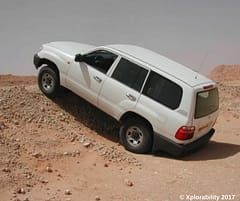
Engine Stall during Ascent
Manual transmission only
Apply Foot Brake only. Avoid using Handbrake if this is a transmission brake as it may lock on and cause problems.
Assess your position.
Check Mirrors for activity behind vehicle.
Test steering wheel and that your wheels are straight. Ensure front wheels are steering in the desired direction, keeping the vehicle vertical to climb.
Using clutch engage reverse Gear, smoothly and quickly. Then remove foot from pedal and place on foot-well floor to avoid the temptation of de-clutching.
Release foot brake momentarily, to ensure reverse gear has been correctly selected.
Reapply Foot Brake.
Recheck Mirrors.
Sound Horn.
Release foot brake while turning the ignition key to start engine. (The load weight of the vehicle on the transmission will ensure that the engine starts and the vehicle will mover rearwards).
As vehicle starts to move, engine braking should be enough to maintain a safe and steady progress rearwards, Hill Descent Control (HDC) will look after the traction issues. For NON – HDC Vehicles, you may cover brakes and control descent to base of slope but do not use too much force as the wheels may lock, if they do, release the brake immediately to regain traction and if necessary gently accelerate to regain directional control. Once you have this decelerate gently.
GENERAL NOTE:
V8 Gasoline/Petrol Engines usually have less engine braking than Diesel Engines so be aware of that as the vehicle may initially start to move backwards quickly and so DO NOT stamp on the brakes. On Non HDC Vehicles cover the brakes gently, release if a wheel locks up. Vehicles with HDC should safely manage your descent.
For Land Rover Discovery 2 owners – Familiarize yourself with the operation of the Traction Control (TC) and Hill Descent Control (HDC) Systems in the separate Training file ABS-TC-HDC
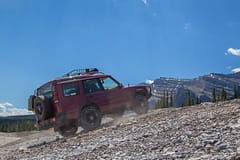
Previous Article: Hazard Identification, Safety and Environment
Next Article: Land Rover Discovery 2 ABS, TC and HDC Guidelines
Related Article: Descending Hills and Slopes
Check out Paul’s action thriller novels here.
Copyright
This content was prepared for the Off-Road Discovery Website by Xplorability 4wd Training
The Content - All Photographs and Photographic Copyright and All other Rights other Reserved October 2017. S.W. France This content may not be copied or reproduced without the written consent of Paul Sinkinson – Xplorability Training
For Use Only in 4wd and Light Vehicle Driver Training.
Not for Re-Publication, Distribution or use outside the Xplorability Training Programme.
